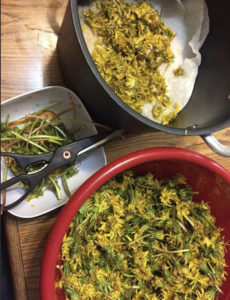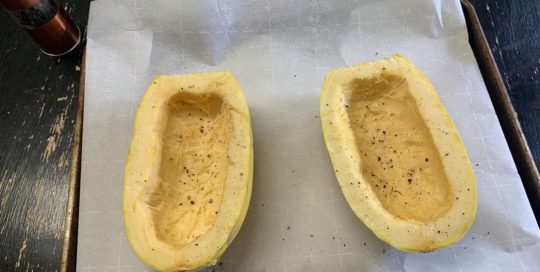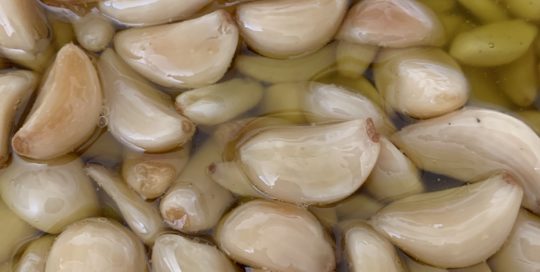How To Make Vegan Dandelion Honey
Views: 467

Dandelions are my favorite flower. Bright and sunny, a cheerful reminder that spring has arrived.
They are also delicious. Dandelion honey is one of my favorite preparations. It’s a great vegan substitute for honey in many dishes. I particularly love it over roasted butternut squash, or as a honey-mustard dip, or drizzled over fruit kebabs.
How do I pick that many dandelions?
The biggest question I get is about how to collect this many dandelion heads. When I was a kid, my mother paid us one penny per two dandelion heads we picked. I’m not sure what inflation has done to the going rate for such a task, but regardless, going out and collecting dandelions can be a fun springtime activity for all ages! I try to leave the stems on and put picked dandelions in cups with a bit of water at the bottom, like a bouquet of flowers.
Scaling the recipe
I’ve included measurements in the recipe, but the basic idea is to have a richly flavored dandelion tea. I’ve found that 1.5–2 densely packed cups of flowers per 1.5 cups of liquid is a pretty good ratio. If you are scaling the recipe or want it more precise, a good trick is to measure the weight of the dandelion liquid after straining it. Then, add the same amount of sugar by weight. Cook it until it’s thick and you should be good to go.
Dandelion Honey
7 oz/ 200 g dandelion petals (about 200 medium to large dandelion heads)
1 quart of water
2 ½ cups white sugar
1 lemon or ¼ cup lemon juice
½ vanilla bean (optional)
Choosing dandelions:
- Make sure you choose pesticide-free dandelions that are away from roads. You want clean petals with no non-food-safe chemicals on them. Not only is this a flavor consideration, but it is also a safety issue.
- Dandelions are edible root-to-stem—the roots are nutty and can be roasted, the greens are peppery and bitter, similar to arugula. If you like, you can harvest a few and try them out in other dishes.
- Dandelions are also early-season pollinators, so while I highly recommend them as a culinary delight, I encourage you to leave many behind for the bees and other pollinators, as well.
Prepare the dandelion petals:
- Shake dandelion flowers to remove bugs and debris. This may require you to use focused air, such as blowing on them or using pressurized air. Gently rinsing the petals can also work. Removing bugs is easier to do while the flowers are open. After they are picked, they often begin to close, so work quickly.
- Trim the dandelion heads, removing green leaves. Kitchen shears are helpful for this task. Doesn’t need to be perfect, but as mentioned before, dandelion greens are fairly bitter (similar to arugula). Leaving greens will change the flavor of the honey.
- Wash petals gently. Be careful not to crush them as you rinse, as the flavor would get washed away.
Make the dandelion tea:
- Add petals to the water in a non-reactive saucepan. Simmer, covered, for 15 minutes, then remove from heat. Cover tightly and allow the petals to steep for 24 hours.
- Strain petals through cheesecloth to remove, reserving liquid. Press down on the petals to get all the flavored juices out. When the petals have been squeezed out, toss them in a compost bin.
Finish the honey:
- Zest the lemon in strips or grate it on a microplane. We’ll use one strip or ½ tsp zest; reserve the rest of the zest for another use.
- Add liquid back to the pot. Add the sugar, the juice from the lemon, and the zest.
- If using vanilla, split and scrape the bean. Use the inner seed caviar and reserve the vanilla pod for another use. Usually, I advise adding the pod to the dish, but in this case, that could overwhelm the dandelion flavor.
- Bring to a boil, swirling the pan gently to avoid burning. Turn the heat to low and simmer gently until the syrup thickens. You’ll want to pull it off the heat while it is thinner than you want it, as it will thicken as it cools.
- Store in sterilized hot jars with lids that seal. Let jars cool. Keep open jars in the fridge and use a clean utensil to remove the honey from the jar.
Chef’s Tip
- If you cook it too long, it will start to caramelize and get hard. Don’t throw it out! As long as it isn’t burned, you can pour out the too-cooked honey quickly onto a nonstick silicone mat or waxed paper. You’ll have delicious dandelion candy! It’s a bummer if you wanted honey, but it’s still incredibly delicious.
Meet Sabina Säfsten
Sabina brings her love of garden-to-table cooking wherever she goes. She has cooked in restaurants, bakeshops, ice cream parlors, and catering kitchens, from prep cook…
Sabina's Recent Posts

Roasted Spaghetti Squash Bowls






